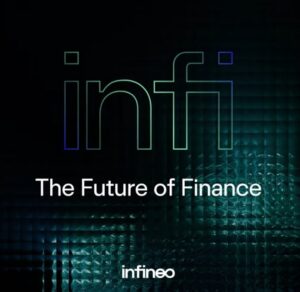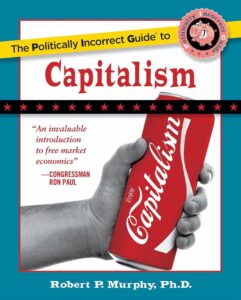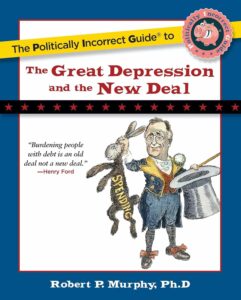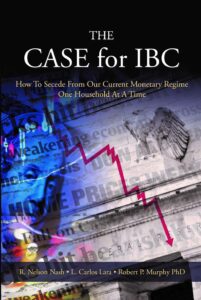Reflections On Mackinac Island
I participated on an energy panel at the Republican Leadership Conference at Mackinac Island on Friday. (I was there in my capacity as an economist with IER. I’m pretty sure they would have me talk at the UAW convention if we were welcome, which we’re not.) Some highlights:
* I met Jay Riemersma who is running for Congress. He had been a tight end for the Buffalo Bills so I had to text my brother and dad. (I grew up in Rochester, NY. The Bills lost the Superbowl every year I was in high school. That seriously affected the trajectory of my life. I’m not kidding.) The guy who introduced us said, “Yeah, Jay here used to play QB, and then he had to put on 30 lbs. for his new job as tight end.” So I said, “That’s funny, when I got hired as an economist I put on 30 lbs. too.” He chuckled, but then again he was running for office.
* I’ve been to this event once before, in 2007. I love it because the guy running for attorney general will stand outside the ferry dock, shaking everybody’s hand. If you explain you’re not a Michigan voter, he’ll say, “You can still vote with your checkbook.” Hey it doesn’t hurt to ask.
* I had a few hours to kill before my talk, so I wandered around the island looking at all the quaint shops. (BTW there are no cars allowed on the island, except some emergency vehicles. Otherwise it’s horses and bicycles. And yes we made the obvious jokes about cap and trade 2 years ago.) The best sign I came across said, “The difference between inlaws and outlaws is that outlaws are wanted.” Ba-DUM.
* When we lived in Hillsdale, MI my wife and I loved the ice cream from “Mackinac Island Creamery.” Well, turns out there is no such thing. First Santa, now this.
* Some guy in the crowd tried to zing me during the Q&A. I was there to discuss the impacts of cap and trade on Michigan’s economy. Now I really did give a big caveat and say, “Nobody knows what the impact of something in 30 years will be, but, the Heritage Foundation used a Global Insight model blah blah blah, and projected an average job loss of 40,000 between the years 2012 and 2030” or something like that. So this guy asks me if that’s really a per year job loss figure. I can see where he’s going–i.e. you’re going to lose more jobs than there are people in Michigan–and so I try to clarify that no, what the figure means is that the model shows the number of jobs below a baseline (with no cap and trade), and that gap is, on average, 40,000 jobs. Then someone else on the panel [who was the local moderator, not an actual presenter] jumps in and says that he’s seen estimates of cap and trade on a national scale, where the loss is 2 million jobs. So the heckler comes back and says, “That’s per year?” and the other guy says, “Yeah.” (I think it’s actually what I was trying to say in reference to the figure I cited for Michigan.) Then the heckler says, “So over a ten-year frame, that’s 10% of the entire US workforce you’re saying will lose their jobs from cap and trade?” and the other guy just goes, “Exactly,” and takes the next question. I think the other guy didn’t really understand the distinction the heckler was making, but I just thought it was hilarious because the heckler was expecting him to slap his head and say, “You’re right, we’ll leave the room now.”
* Apparently these Mackinac Island conferences have a reputation for being quite socially liberal in terms of alcohol. (There was a girl puking in a flowerpot when I walked back to the hotel Friday night from the bar.) Picture it: 2,100 enthusiastic Republicans invade a sleepy island for a weekend, with political groups having open bars all over the place. (And I mean, you go into the actual bar, and the waitresses serve you for free.) If only Robert Wenzel had been there! Then he could have approached two girls and said, “Do you ladies know my famous friend Bob? He corresponds with Glenn Greenwald…”
* Back in 2007, Rudy Giuiliani gave the keynote dinner address, and it truly was a good speech. I thought he had a good shot at being the nominee at that point. In contrast, my chaperone on the island–you can’t let PhDs loose in an unfamiliar place; we might end up in a locker or something–referred to John McCain as “dead man walking” when his procession went by. So, we basically didn’t predict the primaries very well. Anyway, this time around I left Saturday morning, so I didn’t get to hear Mitt Romney give the keynote dinner talk. During the Friday dinner, one of the warmup guys had a good generic line deployed against some Michigan Democrat: “He reminds me of a slinky. He’s not useful for anything, but he’s fun to push down the stairs.” Ba-DUM.
UPDATE: Oh man, I almost forgot to mention that I met Michael Lynch, occasional blogger for MasterResource. (See him take on “peak oil” here, where he defends himself from the critics of his NYT op ed.) Believe it or not, Lynch is a bigger wise*ss than me. (!!) Quick example: We were waiting to get on the ferry, and there was a big yellow school bus that pulled up. Out flowed about 30 kids, probably 10 – 12 years old. Of course they’re all excited to ride the ferry, the chaperones are trying to keep them from jumping into the frigid water, etc. etc. So one girl comes up to us and goes, “We’re here on a field trip. We all go to the same school.” Lynch says, completely deadpan, “Oh, I figured it was either that, or you had all escaped from a prison for really short people.” I’m not kidding, he didn’t crack a smile or anything, he just let the girl process that for a moment and shrug it off as she told her friends they could cut us in line.
Ron Paul Shock Troops Storm Congress
But we’re intellectual geeks so no tear gas was involved. I’m in a hotel right now in Mackinac Island, so I haven’t had time to watch this stuff. But here’s Tom Woods wielding a fiery sword of truth, and below is the only video I’ve found so far. When I get back to the room tonight I’ll post some better stuff.
P.S. As I said, I haven’t had time to watch the above. But I’m pretty sure I recognize the bald spot of the guy on the left of the witness table.
P.P.S. Off topic, but the TVs are blaring this stuff about a guy buying supplies in a beauty shop in order to make a “weapon of mass destruction.” So, if you can build a WMD using Obsession, shouldn’t we admit the War on Terror has as much chance of success as the War on Drugs?
Bush’s Third Term
We need to update that old joke: “People warned me that if I voted for McCain, we’d get another four years of Bush policies. They were right!”
Glenn Greenwald explains:
[W]hen it comes to uprooting (“changing”) the Bush/Cheney approach to Terrorism and civil liberties…the Obama administration has proven rather conclusively that tiny and cosmetic adjustments are the most it is willing to do. They love announcing new policies that cast the appearance of change but which have no effect whatsoever on presidential powers. With great fanfare, they announced the closing of CIA black sites — at a time when none was operating. They trumpeted the President’s order that no interrogation tactics outside of the Army Field Manual could be used — at a time when approval for such tactics had been withdrawn. They repudiated the most extreme elements of the Bush/Addington/Yoo “inherent power” theories — while maintaining alternative justifications to enable the same exact policies to proceed exactly as is. They flamboyantly touted the closing of Guantanamo — while aggressively defending the right to abduct people from around the world and then imprison them with no due process at Bagram. Their “changes” exist solely in theory — which isn’t to say that they are all irrelevant, but it is to say that they change nothing in practice: i.e., in reality.
How to Predict the Coming Bank Pay Regulation
==========
How to Predict the Coming Bank Compensation Regulations
By Robert P. Murphy
In an article that convinced half my readers I was a genius, and half that I was completely insane, I argued that the way to predict the coming moves in currencies and other major financial events was to put yourself in the shoes of the extremely powerful elites who are running the show behind the scenes. Let’s apply that general approach to the specific question of the promised “reform” of compensation at financial institutions. There are more recent articles, but this WSJ story from last week has some great quotes to illustrate my points.
First of all, we need to drop Ayn Rand’s view that big businesses are a persecuted group. Yes, it’s true that governments keep the best legitimate businesspeople from achieving the success that they would on a free market. But what that means is that the potential big businesses are persecuted. Precisely because of onerous government regulations, there is prima facie suspicion that huge businesses right now are using the government to enrich themselves and/or hobble their competitors.
One of the most eye-opening moments in my undergrad education occurred in a Public Choice lecture by Gary Wolfram. Gary (I worked with him later on, so I can call him by his first name now) explained to us that the federal regulations banning cigarette advertisements in many outlets (notice you don’t see Marlboro ads during football games?) were supported by the big tobacco companies. Isn’t that counterintuitive? Fresh from reading Atlas Shrugged, wouldn’t you have guessed that the tobacco executives were throwing darts at pictures of bureaucrats when the new regulations went into effect?
Gary’s explanation was that the tobacco companies had found in their research that advertising didn’t bring in many new smokers, but mostly stole market share from other brands. So if all the tobacco companies could agree to cut back on their advertising, they would all make more money. But of course, that kind of cartel would be hard to police in a free market, especially since a new upstart brand could come in with a big advertising campaign. But the plan could work if the government punished any cheats with big fines. Hence the big tobacco companies benefited from these particular rules, while smaller tobacco companies–especially ones that had a better (in the relevant sense) product–were stifled.
Let’s switch topics now to financial institutions. Let’s suppose the CEOs [UPDATE: It makes more sense to say the major shareholders, not CEOs, have the below conversation, but I’ll leave the dialogue in the original form.] of Goldman Sachs, JP Morgan, and a handful of the other big boys are sitting in a smoke-filled backroom talking shop. The conversation might go like this:
CEO A: “Boy, wouldn’t it be great if we could cut the salaries we pay to our employees across the board? Man, that would be great. It’s not like our top people would go into hotel management or start driving a cab. They’d stick with our firms.”
CEO B: “Yeah, but we could never all agree on the rules and enforce them. Besides, if the public caught wind of it, we’d be toast. Remember the fiasco with the chartered jets?”
CEO C: “Well, what if we got the feds to impose the rules? We could spin it so that it was designed to protect the public from risky positions.”
CEO B: “Give me a break, the public wouldn’t go for that. What if the government proposed cutting teachers’ salaries by 10% across the board in order to raise graduation rates? It’s absurd. We need a better angle.”
CEO D: “Nah nah, he’s onto something there. We could make this work.”
CEO B: “OK fine, let’s assume for the sake of argument that the public buys it. Still, we’d lose our best talent overseas. The SEC and the Fed can’t tell Deutsche Bank how much they can pay their top execs, at least not ones based outside the US.”
CEO A: “Well, what if we got all the major governments on board? Our overseas friends would benefit from the arrangement just as much as we would. The only important thing, would be to install a system that keeps us all honest.”
CEO B: “You guys are crazy. Look, part of our advantage is that we can recruit the best talent. If there is an industry-wide cap, some of our best people might switch to our competitors. How are you going to get people to move to Manhattan, if you can only pay as much as a bank based in Charlotte?”
CEO C: “I got it! We’ll make the new compensation rules favor the big banks. So there will still be overall caps, but the biggest banks will still be able to offer the most lucrative compensation packages, relative to their smaller competitors.”
Is the above a paranoid delusion? You tell me. Here are some choice excerpts from the WSJ piece of September 18:
Policies that set the pay for tens of thousands of bank employees nationwide would require approval from the Federal Reserve as part of a far-reaching proposal to rein in risk-taking at financial institutions.
The Fed’s plan would, for the first time, inject government regulators deep into compensation decisions traditionally reserved for the banks’ corporate boards and executives.
…
The U.S.’s largest banks, about 25 in number, would get especially close scrutiny. The central bank intends to compare these banks as a group to see if any practices stand out as unusually dangerous to their firms.
…
The proposal will likely push banks to use “clawbacks” — provisions to reclaim the pay of staffers who take risks that hurt their firms — in certain pay packages, among other tools, to punish employees for taking excessive risks with their firms’ money.
…
The Fed’s planning comes amid an intensifying global debate about the way bank employees are paid ahead of the Group of 20 meeting of world leaders in Pittsburgh next week. U.S. and foreign officials worry that if they don’t coordinate their rules, some countries could draw talent away from others.
On Thursday, European Union governments issued a communiqué urging the G-20 to adopt strict rules to restrict bonus payments. Speaking after the meeting of EU leaders in Brussels, French President Nicolas Sarkozy said he would support the idea of linking the size of bonuses at each bank to their level of capital.
My tip: If you want to anticipate how these new rules will shake out, just suppose that they are actually being designed by the world’s richest bankers. Because they are.
Robert P. Murphy holds a Ph.D. in economics from New York University. He is the author of The Politically Incorrect Guide to the Great Depression and the New Deal (Regnery, 2009), and is the editor of the blog Free Advice.
Stumped By Stavins
Dan Simmons alerted me to this WSJ article by Harvard’s Robert Stavins. Now I respect Stavins, because he blasted the absurd economic analysis that the California Air Resources Board put out on its statewide cap-and-trade plan. So even though he is a proponent of carbon legislation, I think he’s intellectually honest.
However, in this recent WSJ piece, he’s got two different arguments that seem wrong on the face of them. First let’s look at the iffy one:
Critics argue that we can afford to wait because the world of tomorrow will be wealthier and better able to absorb the costs. But acting sooner, such as by adopting the emission caps proposed in the U.S. House legislation, will lower the ultimate costs of achieving the target, because there will be more time allowed for gradual transition—which is what keeps costs down.
OK on the face of it, this is a bit weird. You keep costs down by giving firms more time to comply. But, I think we all get what Stavins is saying. He’s got in mind a scenario where firms don’t have to do anything for the next twenty years, and they don’t anticipate they will ever have caps imposed in the future, and then Glenn Beck’s coastal house gets flooded and everyone realizes Al Gore was right. So then the government imposes draconian cutbacks in emissions, and everyone slaps his head and realizes the government should have made the hard choices sooner. OK fair enough, but like I said, you need to assume the part about firms being surprised by the caps, or else it doesn’t work.
But now this next one I’m really not sure I follow:
As for how much [the Waxman-Markey cap-and-trade] will cost, the best economic analyses—including studies from the U.S. Congressional Budget Office and the U.S. Energy Information Administration—say such a policy in the U.S. would cost considerably less than 1% of gross domestic product per year in the long term, or up to $175 per household in 2020. (That’s the cost of one postage stamp per household per day.)
If you read it quickly, it sounds like the cost of Waxman-Markey will be a postage stamp a day. But wait a minute, he said (no more than) 1% of GDP per year. Surely the economy (especially “in the long run”) will crank out more than 100 postage stamps per household per day. (In 2007 median household income was over $50,000. Note that $50,000 > $17,500.) So Stavins is giving two different answers here, saying (no more than) 1% of GDP in the long run, OR in the short run, the cost will be up to a postage stamp per day. I don’t think it’s a coincidence that he didn’t actually spell out a concrete number, so that the reader could realize just what “1% of GDP” meant.
Also, there’s the little problem that the CBO report that came out last week said Waxman-Markey would cost the economy anywhere from 1.1% to 3.4% of GDP, by the year 2050. (See Table 1 on page 13 of this pdf.)So I’m not sure how that range translates to “considerably less than 1% of gross domestic product per year in the long run.”
The Worst Sentence I Read Today
From the poor man’s Brad DeLong, Matt Yglesias, who writes:
And in economic terms, there’s really very little difference between spending down a reserve of accumulated cash and in taking advantage of an opportunity to borrow at an extremely low interest rate.
I think by “economic terms,” Yglesias means, “If you stop thinking about it the way a household or company would.”
I warn you, as patently false as you think that statement is, standing alone, if you click on the context you’ll see it’s much worse.
The problem here is that Yglesias thinks the one bad effect of deficit spending is a hike in interest rates. He completely ignores the growth in the federal debt. And what’s worse, he “zings” someone (Michael Boldrin) who wasn’t talking about crowding out, but instead was referring to people trying to save for the future and then having their actions offset by federal profligacy. So even if the government literally borrowed all its money at zero percent, that wouldn’t affect Boldrin’s argument against deficit spending as a means to “stimulate” the economy.
Brad DeLong Continues to Paint Hoover as Mr. Laissez-Faire
As Free Advice readers know, I have taken the Krugman/DeLong side in their debate with the Chicago School. In a nutshell, people like Cochrane and Fama are saying that in principle the government can’t boost nominal spending in the present, as if it’s a matter of accounting. That’s just wrong, especially if you allow for the Fed. (E.g., saying “deficits just rearrange resources” could just as well “prove” that printing money couldn’t possibly provide an artificial boom. The only way to make the argument work is to incorporate “idleness” as part of the legitimate market use of resources–which I do here–but that’s not what Cochrane et al. seem to have in mind.)
But here I think Brad DeLong goes absurdly awry in his counter-counterattack (HT2PK). DeLong quotes Prescott who said:
“I don’t know why Obama said all economists agree on [the need for a stimulus bill]. They don’t. If you go down to the third-tier schools, yes, but they’re not the people advancing the science…” and “the period of the ’20s was one of healthy growth, until Hoover’s anti-market, anti-globalization, anti-immigration, pro- cartelization policies were instituted, brought this expansion to an end, and created a great depression…”
Then DeLong supposedly corrects this historical caricature by saying: “Herbert Hoover was on the right wing of the American political spectrum and tried as best he could to follow pro-market, pro-globalization, pro-competition economic policies…”
In case you’re wondering, not a word in there about how this pro-globalization guy signed off on the Smoot-Hawley tariff, which has a reputation as being anti-globalization. Less famous, Hoover also was proud of the massive turnaround in immigration during the early 1930s. (I don’t remember if he enacted policies to promote this trend, or if it was purely due to the relative deterioration of US job prospects.)
If DeLong wants to challenge Prescott’s statement, I think the onus is on him (DeLong). Oh, and jacking up the top income tax rate from 25% to 63% in one year is also not something that shouts “pro-market” to me. (Look at the rates in 1931 and 1932.) But again, you won’t find any explanation from DeLong on why this is evidence of a hardcore right-winger.
Tom DiLorenzo Hosts Murphy
Details here. And if someone asks me, “Why do white people get paid more?” I’m going to say because they’re blue-eyed devils.







Recent Comments